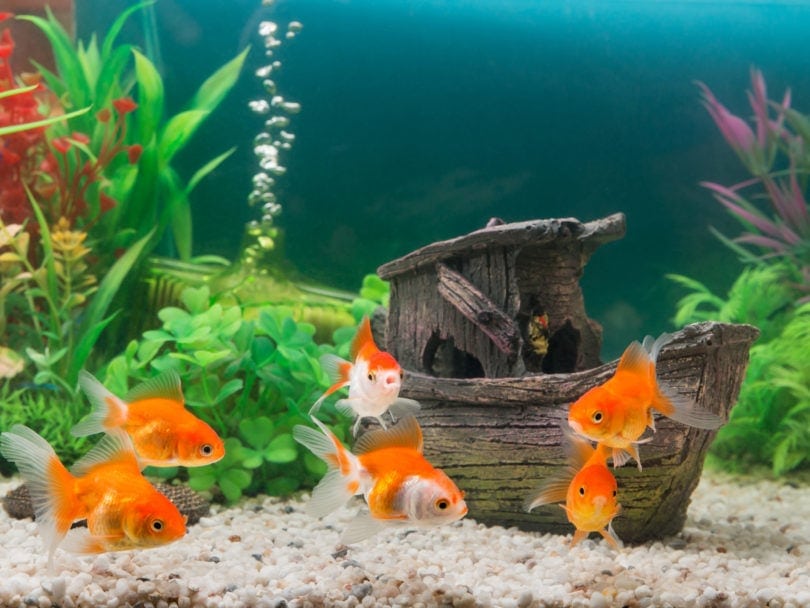Anyone who has ever kept an aquarium has, at one time or another, had to deal with algae. Algae can be difficult to manage and prevent, and often leaves you wanting to pull your hair out. It’s unsightly and it can rob your plants of nutrients, absorb oxygen from the water, and create an all-around unpleasant environment in your aquarium. Some algae treatments can be dangerous if not used correctly, while others just aren’t effective.
One of the most underrated ways to control algae in your tank is by adding algae eating animals. Oftentimes, when people think of “algae eaters”, they imagine a pleco or snails. Then they run to the store, buy one, and toss it in the tank, only to find it won’t eat very much algae at all, or, even worse, it really isn’t compatible in a home with goldfish. Here are reviews of the top algae eating animals you can add to your aquarium to help control the algae without risking the balance of your tank.
 A Quick Comparison of Our Winners (2024)
A Quick Comparison of Our Winners (2024)
| Image | Product | Details | ||
|---|---|---|---|---|
| Best Overall |

|
Worldwide Tropicals Life Freshwater Nerite Snails |
|
Check Price |
| Best Value |

|
One Stop Aquatics Malaysian Trumpet Snails |
|
Check Price |
| Premium Choice |

|
Odyssea Aquarium Panda Corydoras |
|
Check Price |

|
Kazen Aquatic Mix Color Ramshorn Snails |
|
Check Price | |

|
Finchville Aquatics Otocinclus Hoppei |
|
Check Price |
The 6 Best Algae Eaters for Goldfish Tanks
1. Worldwide Tropicals Life Freshwater Nerite Snails – Best Overall
| Growth rate: | Moderate |
| Max size: | 1 inch |
| Temperature needs: | 72–78˚F |
| Lifespan: | 1–2 years |
| Reproduces in freshwater: | No |
The best overall algae eaters for goldfish tanks are easily Nerite snails. These snails are voracious algae eaters that usually will not eat live plants. They help clean up detritus from the floor of the tank and will eat dead and dying plants. These snails can live up to 2 years of age with proper care and stay smaller than some other popular varieties of snails, topping out at approximately 1 inch.
Nerite snails come in a variety of colors and patterns, from racing stripes to zebra stripes, and some even have spiked shells. They are usually too large to be eaten by goldfish, making them great additions to goldfish tanks. They are moderately active snails, so you may see them scooting around the tank as they go about their day. Be aware, though, that Nerite snails are mostly nocturnal, so it’s not unusual to see them being inactive during daytime hours.
These snails prefer water temperatures in the low end of tropical ranges, so you will need to closely monitor water temperatures to ensure they stay at a level that is comfortable for goldfish and Nerites. Nerite snails cannot reproduce in freshwater, but they will lay eggs everywhere. These eggs won’t hatch and will need to be cleaned up by hand if their appearance bothers you.
2. One Stop Aquatics Malaysian Trumpet Snails – Best Value
| Growth rate: | Moderate |
| Max size: | 1 inch |
| Temperature needs: | 64–86˚F |
| Lifespan: | 1–2 years |
| Reproduces in freshwater: | Yes |
The best algae eaters for goldfish tanks for the money is Malaysian Trumpet snails. These cute snails are shaped like spiral unicorn horns and max out at around 1 inch in length. They usually live for around 1 year, although many people have reported lifespans of 2 years or more with excellent care. These algae eating snails love to burrow, making them great additions to tanks with soft substrate that needs to be turned, like sand.
MTS love to eat algae, but will also eat leftover food from the substrate, dead and dying plants, and just about any food offerings you provide to them. They are most active at night, so it’s not unusual to rarely see your MTS.
These snails reproduce asexually, which has earned them a reputation for being pest snails. To prevent a major population boom, it’s important to ensure you aren’t overfeeding your tank. They usually will only reproduce based on the availability of food.
3. Odyssea Aquarium Panda Corydoras – Premium Choice
| Growth rate: | Slow |
| Max size: | 5 inches |
| Temperature needs: | 65–75˚F |
| Lifespan: | 5 years |
| Reproduces in freshwater: | Yes |
The premium choice for algae eaters for goldfish tanks is the Corydora catfish. These thick-bodied fish only reach around 2.5 inches in length and can exceed 5 years of age with proper care. In the wild, they thrive in water temperatures as low as 60˚F, so they can live happily within the preferred temperature range of goldfish. These fish can breathe room air much like goldfish can, so they can survive in low oxygen environments.
There are lots of varieties of Cory catfish, including albino and “panda”. They are the best fish for eating algae in goldfish tanks but do require supplemental feeding since they are omnivorous. These egg-laying fish are not picky when it comes to reproducing in the tank environment, so if the eggs and hatchling fry can survive the goldfish in the tank, you will be able to keep a breeding population.
Many Corydoras are wild caught, which can make it difficult and stressful for them to adapt to the home aquarium environment. Most Corys are more expensive than your average pet store fish, so be prepared for the premium price associated with these fish.
4. Kazen Aquatic Mix Color Ramshorn Snails
| Growth rate: | Rapid |
| Max size: | 1 inch |
| Temperature needs: | 60–80˚F |
| Lifespan: | 1 year |
| Reproduces in freshwater: | Yes |
Ramshorn snails are a popular aquatic snail that are hardy and can live in aquarium and pond environments. These snails are available in a variety of colors and have ramshorn-shaped shells, giving them their name. They usually stay below an inch in diameter and are great algae eaters and detritivores.
These snails reproduce asexually and do so readily, much like Malaysian Trumpet snails. Ramshorn snails are frequently acquired as hitchhikers on plants. They thrive in a very large temperature range, making them ideal tank mates for goldfish.
These snails reproduce readily and reach sexual maturity within only about two months after birth, earning them a reputation as pest snails. They are egg-layers and are known for their spiral-shaped egg clutches, which they will lay on just about any surface within the tank.
Housing a goldfish isn't as simple as buying a bowl. If you're a new or experienced goldfish keeper who wants to get the setup right for your goldfish family, check out the best-selling book, The Truth About Goldfish, on Amazon.
It covers all you need to know about the ideal tank setup, tank size, substrate, ornaments, plants, and so much more!
5. Finchville Aquatics Otocinclus Hoppei
| Growth rate: | Moderate |
| Max size: | 2 inches |
| Temperature needs: | 72–82˚F |
| Lifespan: | 5–7 years |
| Reproduces in freshwater: | Yes |
The cute Otocinclus Hoppei, or Otocinclus catfish, can be a great addition to goldfish tanks, especially while goldfish are still small. They can reach up to 2 inches in length and thrive in temperatures as low as 72˚F. They can live up to 7 years with proper care in a home aquarium.
These petite catfish reproduce when they feel safe and comfortable in their aquarium environment. They are egg-layers and will lay their eggs on surfaces, including the tank glass. They almost exclusively eat algae and are very efficient at it, which means you may need to supplement their diet with algae wafers and other algae eater foods to ensure they are getting enough to eat.
Otocinclus catfish prefer to be kept in small groups, so you will likely need to get multiple. They are small, which makes them susceptible to being eaten by large goldfish. The low end of their temperature range barely overlaps with the upper end of the temperature range that is most comfortable for goldfish, so you’ll have to monitor the water temperature closely.
6. Polar Bear’s Pet Shop 3 Striped Hillstream Loaches
| Growth rate: | Slow to moderate |
| Max size: | 3 inches |
| Temperature needs: | 65–75˚F |
| Lifespan: | 8–10 years |
| Reproduces in freshwater: | Yes |
The Hillstream loach is a unique addition to a home aquarium. They are cool-water fish, like goldfish, and while they do prefer some current, it does not need to be strong. These unusual looking fish can reach up to 3 inches in length and many people have reported them living up to 10 years or more with excellent care.
These fish are one of the easiest varieties of loach to breed. They are egg-layers and make use of egg-laying pits that the male guards, giving them a chance at reproduction, even with goldfish present. They almost exclusively eat algae and dead plant matter, but they do need some protein supplementation in their diet by way of bloodworms, Mysis shrimp, and other aquatic proteins.
Hillstream loaches are relatively shy fish, so you’ll need to ensure they are only kept with goldfish that will not chase or harass them. They are a premium price and can be difficult to find.
 Buyer’s Guide: Choosing the Best Algae Eater for Goldfish Tanks
Buyer’s Guide: Choosing the Best Algae Eater for Goldfish Tanks
Do Algae Eaters Need Additional Food?
Yes! Algae eaters will, obviously, eat algae within your tank, but this isn’t enough. Some algae eaters are omnivorous, which means they will require supplemental proteins, as well as vitamins and minerals like calcium. Other algae eaters that almost exclusively eat algae still require supplemental feedings to ensure they are getting enough to eat.
One of the most common mistakes that people make with algae eaters, especially algae eating fish, is assuming that they don’t need to feed them. This usually leads to a slow, miserable death by starvation for the algae eaters. The algae in your tank is almost never enough to support an algae eater forever.
Final Thoughts
If you’re considering algae eaters for your goldfish tank, did you find these reviews helpful? Your best option for algae eating snails is Nerite snails, which are also the best overall option for algae eaters for goldfish tanks. The best algae eating fish for goldfish tanks is Corydoras, which are effective algae eaters, but do usually come at a premium price. Malaysian Trumpet snails are going to be the best algae eaters for the money, but their reputation as pest snails may make you uninterested in giving them a try.
- Related read: 10 Popular Types of Cory Catfish (With Pictures)
Featured Image Credit: Amazon

















